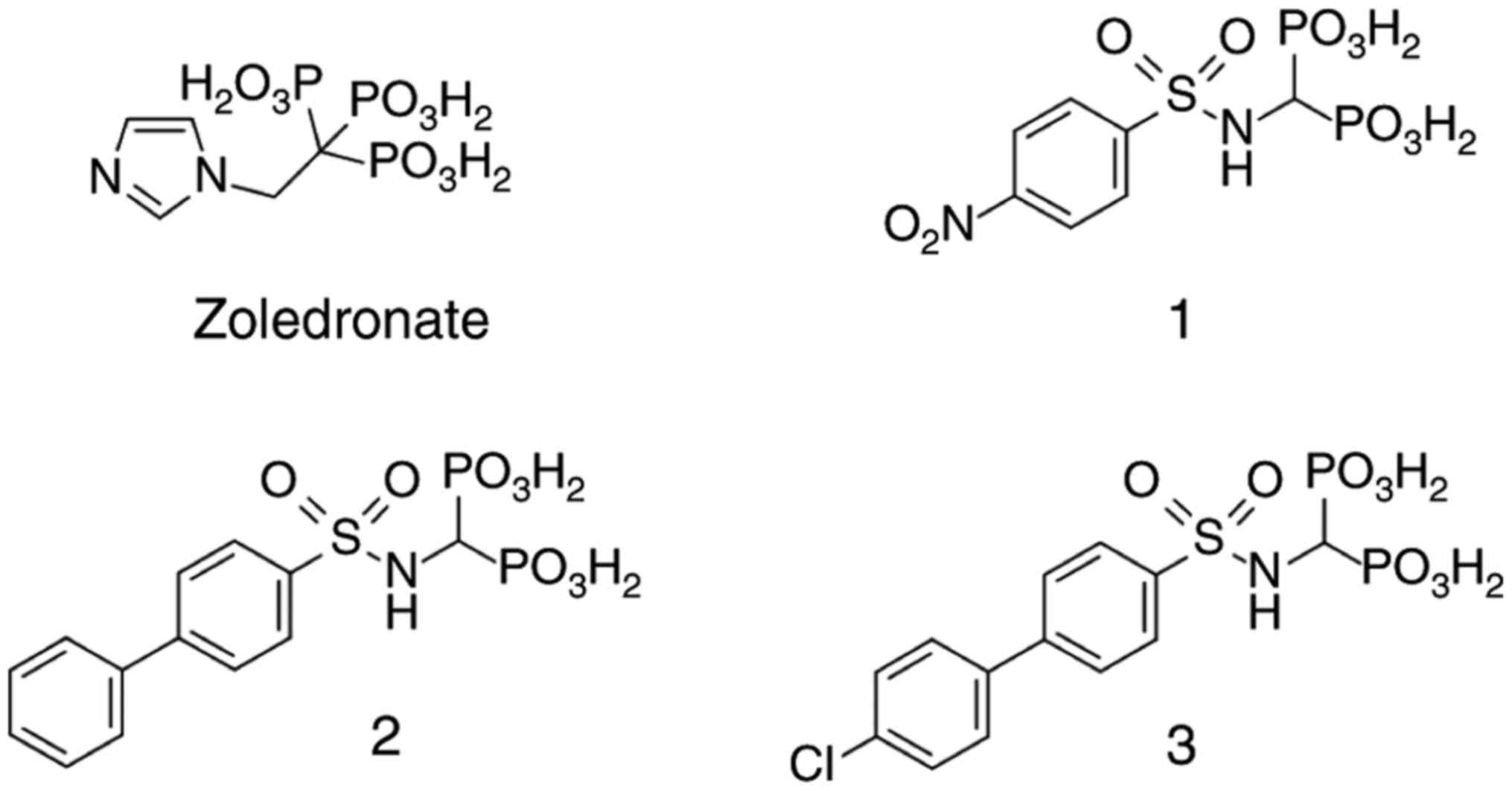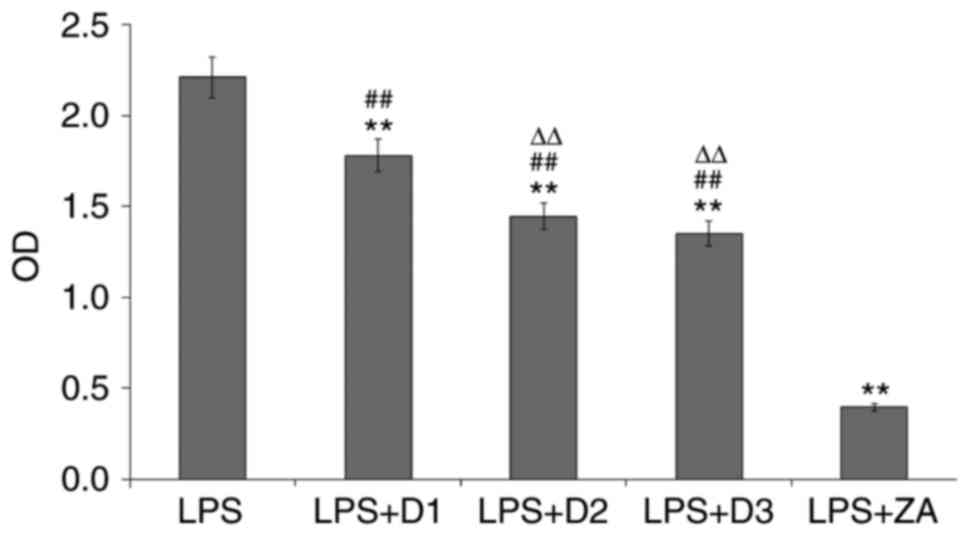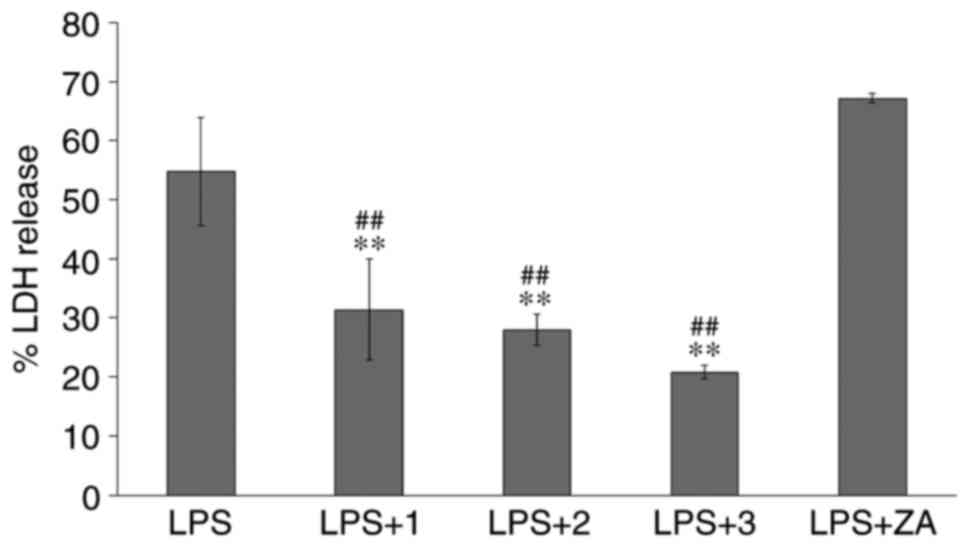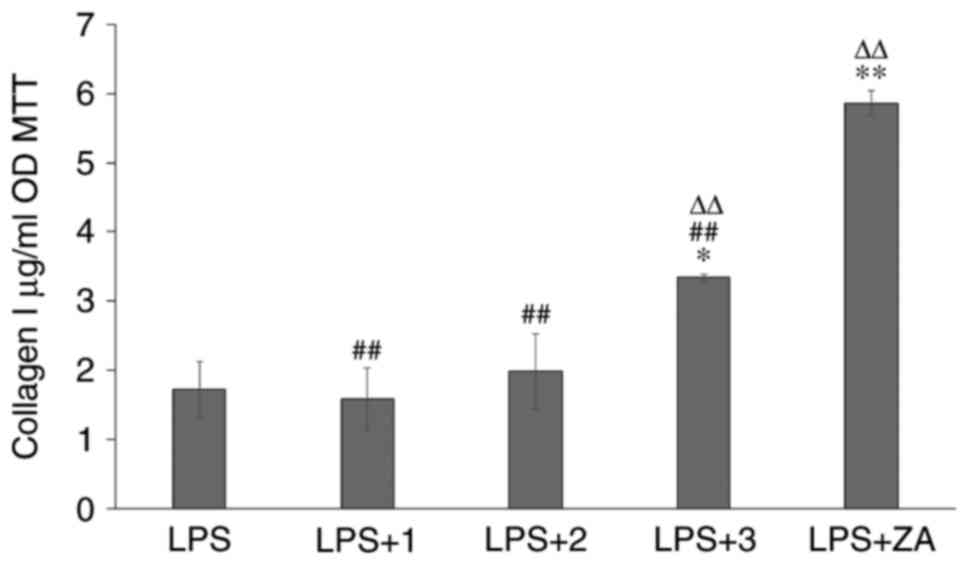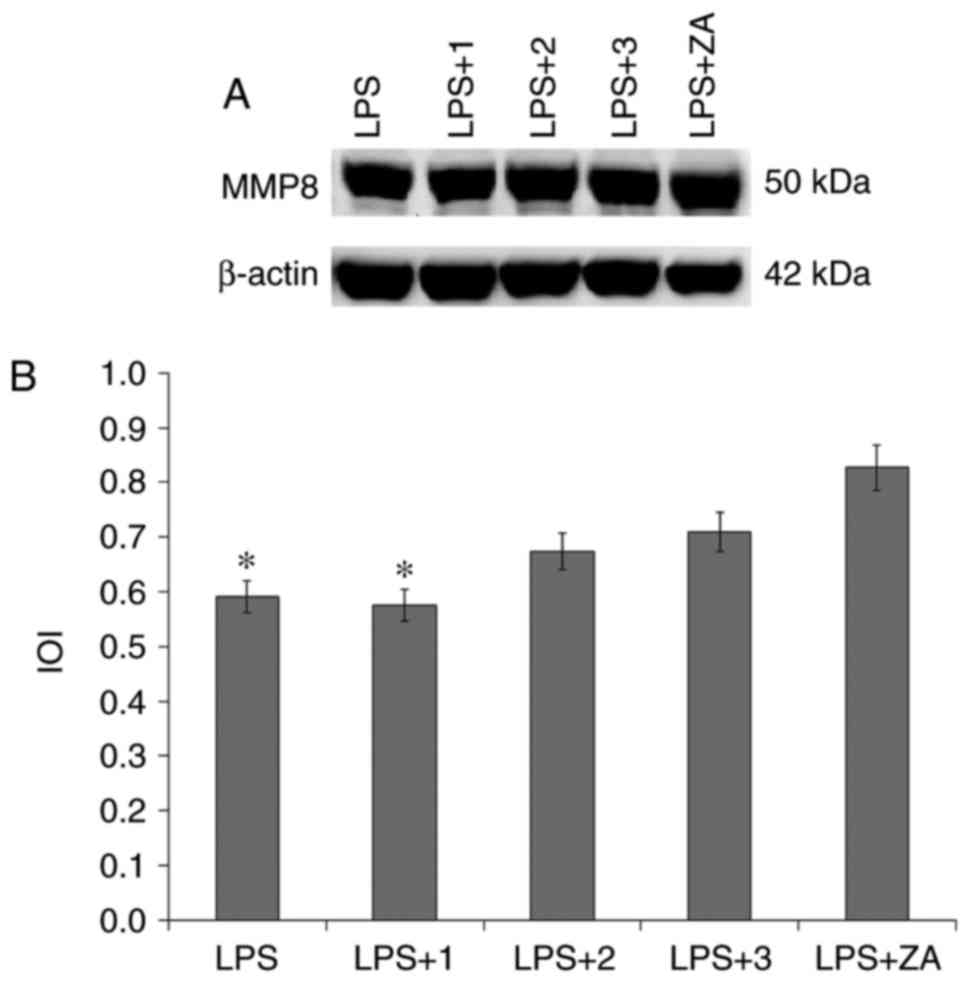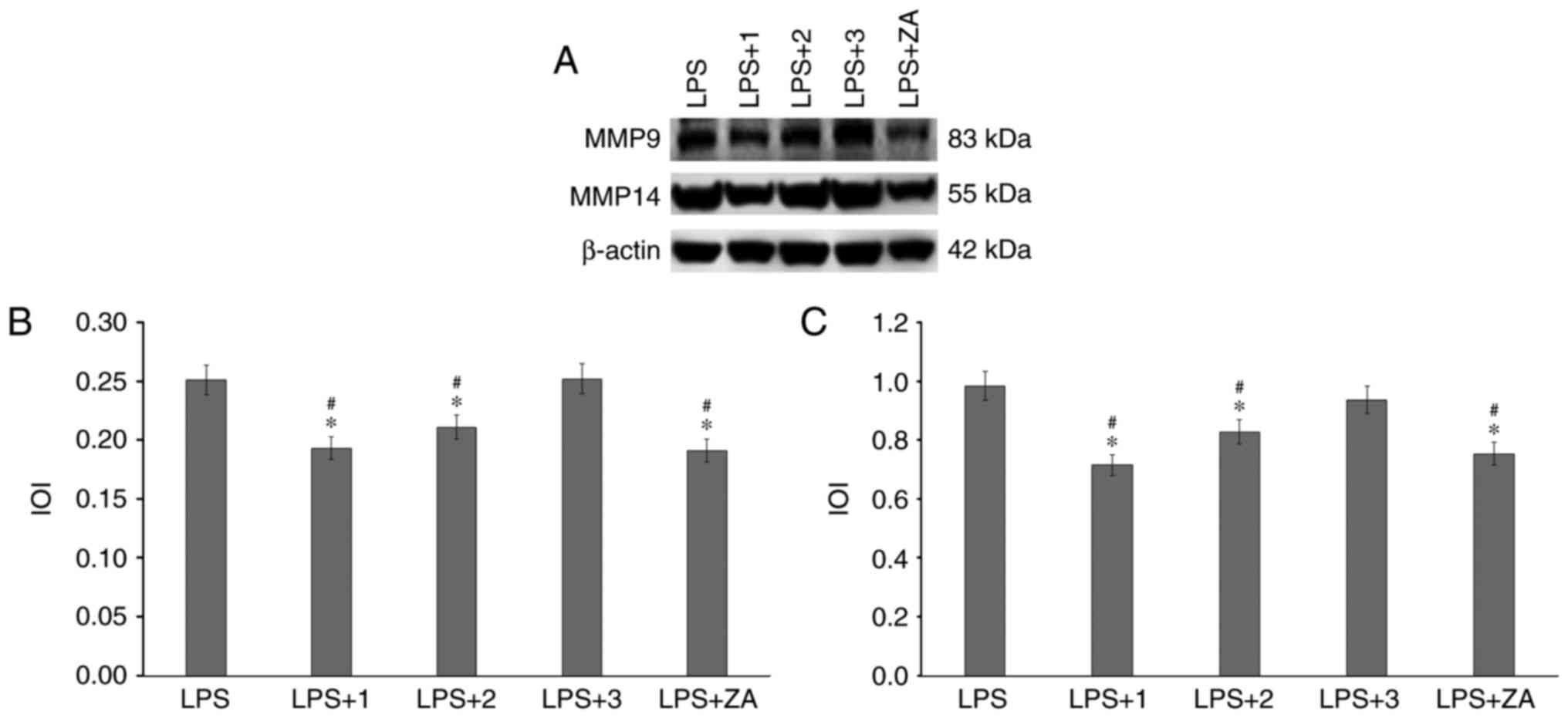|
1
|
Laine ML, Crielaard W and Loos BG: Genetic
susceptibility to periodontitis. Periodontol 2000. 58:37–68. 2012.
View Article : Google Scholar
|
|
2
|
Darveau RP: Periodontitis: A polymicrobial
disruption of host homeostasis. Nat Rev Microbiol. 8:481–490. 2010.
View Article : Google Scholar : PubMed/NCBI
|
|
3
|
Herath TD, Wang Y, Seneviratne CJ, Lu Q,
Darveau RP, Wang CY and Jin L: Porphyromonas gingivalis
lipopolysaccharide lipid A heterogeneity differentially modulates
the expression of IL-6 and IL-8 in human gingival fibroblasts. J
Clin Periodontol. 38:694–701. 2011. View Article : Google Scholar : PubMed/NCBI
|
|
4
|
Park BS and Lee JO: Recognition of
lipopolysaccharide pattern by TLR4 complexes. Exp Mol Med.
45:e662013. View Article : Google Scholar : PubMed/NCBI
|
|
5
|
Garcia de Aquino S, Manzolli Leite FR,
Stach-Machado DR, Francisco da Silva JA, Spolidorio LC and Rossa C
Jr: Signaling pathways associated with the expression of
inflammatory mediators activated during the course of two models of
experimental periodontitis. Life Sci. 84:745–754. 2009. View Article : Google Scholar : PubMed/NCBI
|
|
6
|
Martinho FC, Leite FR, Nóbrega LM, Endo
MS, Nascimento GG, Darveau RP and Gomes BP: Comparison of
Fusobacterium nucleatum and Porphyromonas gingivalis
lipopolysaccharides clinically isolated from root canal infection
in the induction of pro-inflammatory cytokines secretion. Braz Dent
J. 27:202–207. 2016. View Article : Google Scholar : PubMed/NCBI
|
|
7
|
Darveau RP, Pham TT, Lemley K, Reife RA,
Bainbridge BW, Coats SR, Howald WN, Way SS and Hajjar AM:
Porphyromonas gingivalis lipopolysaccharide contains multiple lipid
A species that functionally interact with both toll-like receptors
2 and 4. Infect Immun. 72:5041–5051. 2004. View Article : Google Scholar : PubMed/NCBI
|
|
8
|
Hannas AR, Pereira JC, Granjeiro JM and
Tjäderhane L: The role of matrix metalloproteinases in the oral
environment. Acta Odontol Scand. 65:1–13. 2007. View Article : Google Scholar : PubMed/NCBI
|
|
9
|
Sorsa T, Tjäderhane L, Konttinen YT,
Lauhio A, Salo T, Lee HM, Golub LM, Brown DL and Mäntylä P: Matrix
metal-loproteinases: Contribution to pathogenesis, diagnosis and
treatment of periodontal inflammation. Ann Med. 38:306–321. 2006.
View Article : Google Scholar
|
|
10
|
Mäntylä P, Stenman M, Kinane DF, Tikanoja
S, Luoto H, Salo T and Sorsa T: Gingival crevicular fluid
collagenase-2 (MMP-8) test stick for chair-side monitoring of
periodontitis. J Periodontal Res. 38:436–439. 2003. View Article : Google Scholar : PubMed/NCBI
|
|
11
|
Lagente V and Boichot E: Role of matrix
metalloproteinases in the inflammatory process of respiratory
diseases. J Mol Cell Cardiol. 48:440–444. 2010. View Article : Google Scholar
|
|
12
|
Sorsa T, Tjäderhane L and Salo T: Matrix
metalloproteinases (MMPs) in oral diseases. Oral Dis. 10:311–318.
2004. View Article : Google Scholar : PubMed/NCBI
|
|
13
|
Agarwal S, Misra R and Aggarwal A:
Induction of metalloproteinases expression by TLR ligands in human
fibroblast like synoviocytes from juvenile idiopathic arthritis
patients. Indian J Med Res. 131:771–779. 2010.PubMed/NCBI
|
|
14
|
Vincenti MP and Brinckerhoff CE:
Transcriptional regulation of collagenase (MMP-1, MMP-13) genes in
arthritis: Integration of complex signaling pathways for the
recruitment of gene-specific transcription factors. Arthritis Res.
4:157–164. 2002. View
Article : Google Scholar : PubMed/NCBI
|
|
15
|
Dufour A and Overall CM: Missing the
target: Matrix metal-loproteinase antitargets in inflammation and
cancer. Trends Pharmacol Sci. 34:233–242. 2013. View Article : Google Scholar : PubMed/NCBI
|
|
16
|
Aschi M, Besker N, Re N, Pochetti G,
Coletti C, Gallina C and Mazza F: Stereoselectivity by enantiomeric
inhibitors of matrix metalloproteinase-8: New insights from
molecular dynamics simulations. J Med Chem. 50:211–218. 2007.
View Article : Google Scholar : PubMed/NCBI
|
|
17
|
Di Pizio A, Laghezza A, Tortorella P and
Agamennone M: Probing the S1′ site for the identification of
non-zinc-binding MMP-2 Inhibitors. ChemMedChem. 8:1475–1482. 2013.
View Article : Google Scholar
|
|
18
|
Campestre C, Tortorella P, Agamennone M,
Preziuso S, Biasone A, Nuti E, Rossello A and Gallina C: Peptidyl
3-substituted 1-hydroxyureas as isosteric analogues of
succinylhydroxamate MMP inhibitors. Eur J Med Chem. 43:1008–1014.
2008. View Article : Google Scholar
|
|
19
|
Campestre C, Agamennone M, Tauro M and
Tortorella P: Phosphonate emerging zinc binding group in matrix
metalloproteinase inhibitors. Curr Drug Targets. 16:1634–1644.
2015. View Article : Google Scholar : PubMed/NCBI
|
|
20
|
Giustiniano M, Tortorella P, Agamennone M,
Di Pizio A, Rossello A, Nuti E, Gomez-Monterrey I, Novellino E,
Campiglia P, Vernieri E, et al: Amino acid derivatives as new zinc
binding groups for the design of selective matrix
metallo-proteinase inhibitors. J Amino Acids. 2013:1783812013.
View Article : Google Scholar
|
|
21
|
Rubino MT, Agamennone M, Campestre C,
Campiglia P, Cremasco V, Faccio R, Laghezza A, Loiodice F, Maggi D,
Panza E, et al: Biphenyl sulfonylamino methyl bisphosphonic acids
as inhibitors of matrix metalloproteinases and bone resorption.
ChemMedChem. 6:1258–1268. 2011. View Article : Google Scholar : PubMed/NCBI
|
|
22
|
Tauro M, Loiodice F, Ceruso M, Supuran CT
and Tortorella P: Dual carbonic anhydrase/matrix metalloproteinase
inhibitors incur porating bisphosphonic acid moieties targeting
bone tumors. Biooorg Med Chem Lett. 24:2617–2620. 2014. View Article : Google Scholar
|
|
23
|
De Colli M, Tortorella P, Marconi GD,
Agamennone M, Campestre C, Tauro M, Cataldi A and Zara S: In vitro
comparison of new bisphosphonic acids and zoledronate effects on
human gingival fibroblasts viability, inflammation and matrix
turnover. Clin Oral Invest. 20:2013–2021. 2016. View Article : Google Scholar
|
|
24
|
Zhao L, Marquis A, La VD, Agamennone M,
Loiodice F, Tortorella P and Grenier D: Effects of biphenyl
sulfonylamino methyl bisphosphonic acids on Porphyromonas
gingivalis and cytokine secretion by oral epithelial cells. Med
Chem. 9:855–860. 2013. View Article : Google Scholar
|
|
25
|
Ettorre V, De Marco P, Zara S, Perrotti V,
Scarano A, Di Crescenzo A, Petrini M, Hadad C, Bosco D, Zavan B, et
al: In vitro and in vivo characterization of graphene oxide coated
porcine bone granules. Carbon. 103:291–298. 2016. View Article : Google Scholar
|
|
26
|
Stamatova I and Meurman JH: Probiotics and
periodontal disease. Periodontol 2000. 51:141–151. 2009. View Article : Google Scholar : PubMed/NCBI
|
|
27
|
Picolos DK, Lerche-Sehm J, Abron A, Fine
JB and Papapanou PN: Infection patterns in chronic and aggressive
periodontitis. J Clin Periodontol. 32:1055–1061. 2005. View Article : Google Scholar : PubMed/NCBI
|
|
28
|
Nip LH, Uitto VJ and Golub LM: Inhibition
of epithelial cell matrix metalloproteinases by tetracyclines. J
Periodont Res. 28:379–385. 1993. View Article : Google Scholar : PubMed/NCBI
|
|
29
|
Biasone A, Tortorella P, Campestre C,
Agamennone M, Preziuso S, Chiappini M, Nuti E, Carelli P, Rossello
A, Mazza F and Gallina C: Alpha-biphenylsulfonylamino
2-methylpropyl phosphonates: Enantioselective synthesis and
selective inhibition of MMPs. Bioorg Med Chem. 15:791–799. 2007.
View Article : Google Scholar
|
|
30
|
Wiktorowska-Owczarek A, Namiecińska M and
Owczarek J: The effect of ibuprofen on BFGF, VEGF secretion and
cell proliferation in the presence of lps in hmec-1 cells. Acta Pol
Pharm. 72:889–894. 2015.PubMed/NCBI
|
|
31
|
Xi ZD, Xie CY and Xi YB: Macrophage
migration inhibitory factor enhances lipopolysaccharide-induced
fibroblast proliferation by inducing toll-like receptor 4. BMC
Musculoskelet Disord. 17:432016. View Article : Google Scholar : PubMed/NCBI
|
|
32
|
De Colli M, Zara S, di Giacomo V, Patruno
A, Marconi GD, Gallorini M, Zizzari VL, Tetè G and Cataldi A:
Nitric oxide-mediated cytotoxic effect induced by zoledronic acid
treatment on human gingival fibroblasts. Clin Oral Investig.
19:1269–1277. 2015. View Article : Google Scholar
|
|
33
|
Açil Y, Möller B, Niehoff P, Rachko K,
Gassling V, Wiltfang J and Simon MJ: The cytotoxic effects of three
different bisphos-phonates in-vitro on human gingival fibroblasts,
osteoblasts and osteogenic sarcoma cells. J Craniomaxillofac Surg.
40:e229–e235. 2012. View Article : Google Scholar
|
|
34
|
Anitua E, Zalduendo M, Troya M and Orive
G: PRGF exerts a cytoprotective role in zoledronic acid-treated
oral cells. Clin Oral Investig. 20:513–521. 2016. View Article : Google Scholar
|
|
35
|
Subramani T, Rathnavelu V, Alitheen NB and
Padmanabhan P: Cellular crosstalk mechanism of Toll-like receptors
in gingival overgrowth (Review). Int J Mol Med. 35:1151–1158. 2015.
View Article : Google Scholar : PubMed/NCBI
|
|
36
|
Dejonckheere E, Vandenbroucke RE and
Libert C: Matrix metalloproteinase8 has a central role in
inflammatory disorders and cancer progression. Cytokine Growth
Factor Rev. 22:73–81. 2011. View Article : Google Scholar : PubMed/NCBI
|
|
37
|
Kiili M, Cox SW, Chen HY, Wahlgren J,
Maisi P, Eley BM, Salo T and Sorsa T: Collagenase-2 (MMP-8) and
collagenase-3 (MMP-13) in adult periodontitis: Molecular forms and
levels in gingival crevicular fluid and immunolocalisation in
gingival tissue. J Clin Periodontol. 29:224–232. 2002. View Article : Google Scholar : PubMed/NCBI
|



